Marketing Trends for 2016 – Will we be in a post-digital era?
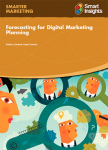
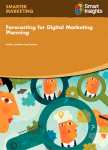
Our look at the latest trends in digital media and technology and how they will impact marketing this year
At the start of each year, there is always a lot of interest in predictions for the year ahead and the latest marketing trends.”What’s Hot?” and “What’s Next?” are always the most common questions when I give webinars and talks! As we near the end of the first month of 2016, and people look to the year ahead, the interest increases. Since it’s that time again, in this post and a series of others looking at customer lifecycle tactics, I’ll look at what I see as the latest trends in marketing which look set to continue into the rest of 2016.
Download Expert Member resource – Marketing Forecasting Techniques guide
In this guide we review the techniques which are most relevant to creating forecasts given the impact of digital disruption. This guide is a briefing on 8 key techniques. It is designed to help all those involved in marketing who are keen to support the change process in their organisation to make more use of digital marketing.
Access the Marketing Forecasting techniques for marketing planning guide
What do you think will be single biggest trend in digital media and technology in 2016?
To inform my thinking on marketing innovation, I’m always interested to hear the view of “hands-on” marketers in businesses running digital marketing activities as to what they see as the most important trends and I’m grateful for readers input into research like that shared in our Managing Digital Marketing report with TFM.
Since we’re talking trends, I’m interested to hear your opinion on THE biggest trend in digital marketing as shown by what will make the most difference to your business (or your clients if you work for an agency or as a consultant), i.e. which digital marketing technique will give you the most uplift or incremental benefits.
So in this quick poll, please share your view on which single digital marketing technique do you think will make the biggest commercial impact for you in 2015? It’s interesting to see how the top rated techniques change from year-to-year!
View Poll
This graph shows the results of our survey at the time of posting. It will be interesting to see how these change as more marketers take our survey.
Trends in consumer purchase behaviour
Following the views from marketers and businesses, changes in consumer use of digital media and technology is core to understanding trends in digital marketing. Today’s consumer buying decision is certainly getting more complex…
The increasing complexity of the purchase decision
We’re continuing to see consumer decision behaviour increase in complexity. This example of today’s complex consumer purchase behaviour from research analysts GfK shows the complexity of today’s customer journeys across multiple devices and through time, particularly for high involvement or high-value purchases, such as insurance in this instance.
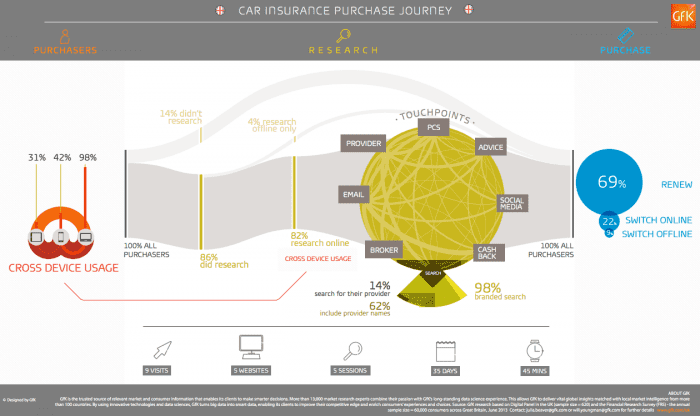
The graphic shows how involved today’s purchase decision is. Over a 35 day period it averaged 9 visits to 5 different websites amounting to 34 minutes in total. The influence of online channels is clear with 82% of purchasers researching online against 4% using offline only.
Increasing mobile usage
This year we have also seen a continued strong growth in mobile use, shown clearly by Mary Meeker’s annual mobile trends round-up from earlier in the year. So, unsuprisingly, the use of mobile marketing will continue to be one of key trends to follow in 2016.
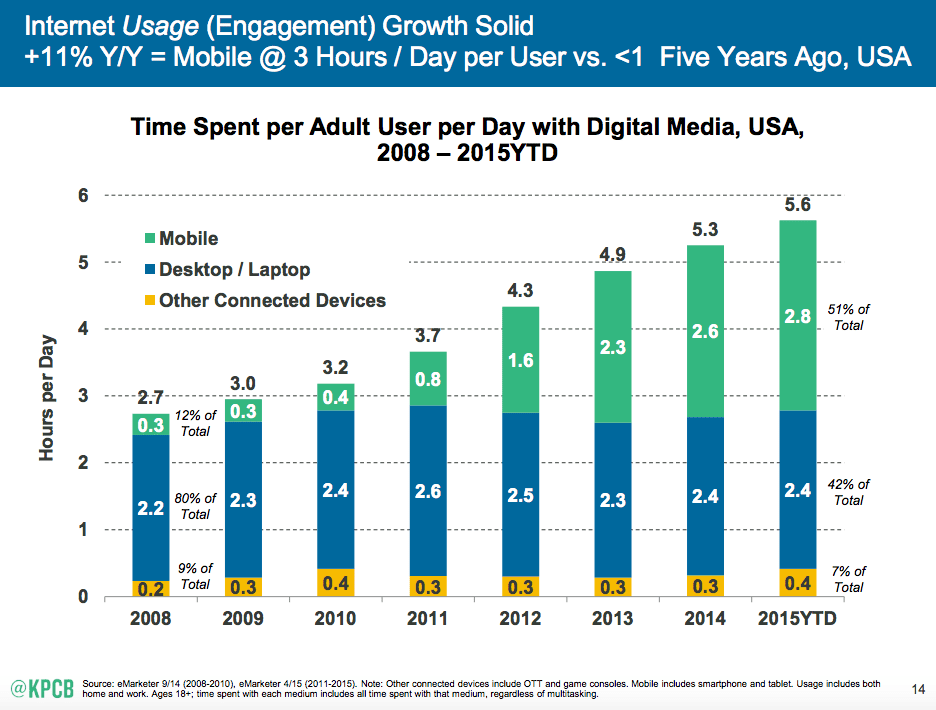
Digital Transformation: From ‘Digital Silos’ to Integrated teams
For some time, there has been increasing talk of a need for a ‘post-digital marketing world’ marketing world where the use of digital media and technology in marketing has become so ubiquitous we no longer complete separate “digital marketing activities” since they should be fully integrated and simply part of marketing. This thinking is partly driven by changes in consumer media consumption where they continue to consume content in different formats without consciously thinking about which devices or channels. The ‘post-digital’ thinking is also driven by problems of managing marketing activities in a business where a common problem with upskilling in digital is that ‘digital silos’ are created where different parts of marketing and their agencies don’t communicate effectively giving rise to campaigns that don’t work across media.
For example, according to an interview with TFM, HSBC global head of marketing for commercial banking and global banking and markets, Amanda Rendle, has said she has banned the word ‘digital’ to encourage her team to think beyond organisational silos. Rendle says:
“We need to go back to what marketing is, and the product is marketing. More people need to remember that, get off the drug of digital being something separate and get back to what we do best“.
She says the types of roles she is looking for might end up being called customer engineers or customer journey engineers. A key problem for HSBC, she says, is that it has an abundance of insights on customers but having staff to translate that into actions is a hindrance.
“We need customer insight roles where their job is insight but it’s also about looking at what do those insights really mean? You have so much insight now but can you tell me what we need to do? How do you take all that and turn it into something really useful for our customer? That’s what we absolutely should be doing.”
Similarly Jeff Dodds, the Chief Executive of Tele 2 Netherlands since April 2014 and previously CMO for Virgin Media speaking to the CIM Catalyst magazine in Sept 2014 says:
“To talk about digital as some kind of separate entity is to not understand it. Our lives ARE digital is not a thing, it is simply a more flexible, response and efficient way to do business.”
He continues,
“There is too much talk about roles: digital job titles, digital strategies”. Digital is not something that needs a job title. This perpetuates the myth that it is a singular, siloed thing. I find some of the terminology that is used incredibly frustrating“.
Interesting. This certainly shows the way thinking should be heading in future, but it’s a long way from the reality for many businesses who are only just starting to get to adjust to digital marketing. In his article, A “Post Digital” World, Really?, Y&R Chairman and CEO David Sable makes the case that, far from being post-digital, we are only at the beginning of being digital, and that fresh ideas can be found everywhere.
When I talk to businesses and we ask businesses to rate their digital capabilities I find that many are an early stage of adopting digital marketing techniques. Results from our new interactive “Digital Marketing Benchmarking tool” which asks about the detail of what could and should be marketing, shows that many are still at level 1 or 2 on a 5 point maturity scale.
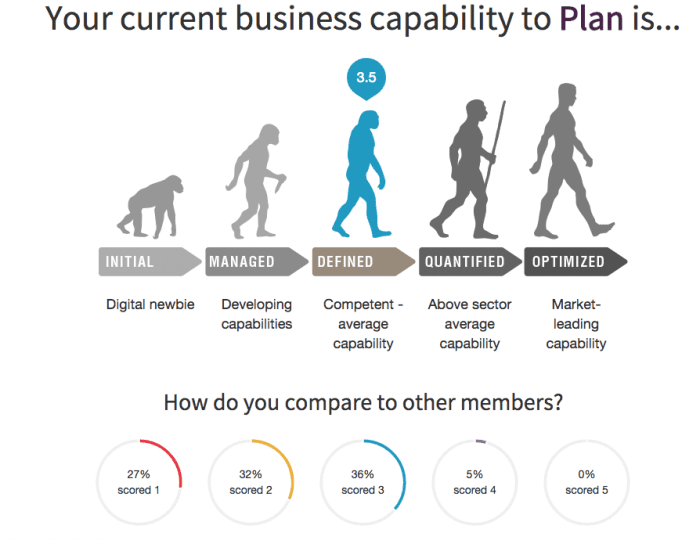
The way I see it, at early levels of adoption you have to make the commitment to transform marketing by setting goals for digital marketing, setting an integrated digital strategy and bringing in specialist digital marketing skills – through a combination of new hires for new roles, use of agencies and re-skilling existing marketers. New marketing processes are also needed which integrate digital to the heart of strategy, investment and marketing campaigns. Naturally this can’t happen overnight, particularly since changes in marketing technology are also needed to support the integration of digital marketing, so many businesses now have digital transformation programmes to support this.
Ultimately the aim in the mature organisations should be to reduce specialist digital skills and agencies as digital becomes integrated as part of marketing activities. Digital silos should shrink and specialist Digital marketing managers should reduce in number although I believe there will always be a need for a ‘Digital Centre of Excellence’ to evaluate the latest digital marketing trends, set standards, manage technology projects and complete advanced optimisation.
The rise of the Chief Marketing Technologist
Another trend within the management of marketing today is the shift in control of marketing technology from IT and Sales to Marketing. Selecting the most relevant Martech from the increasingly complex Marketing Technology landscape is a major challenge as we now literally have thousands of different cloud services vying to be part of the Marketing Stack.
The challenge of integrating digital and traditional marketing
Our research on Managing Digital Marketing suggested progress as marketers move towards integrated planning of digital and traditional activities, but there is still plenty of room for improvement with only one-quarter of companies satisfied with their level of integration across digital and traditional communications and 7% fully integrated and optimised.’
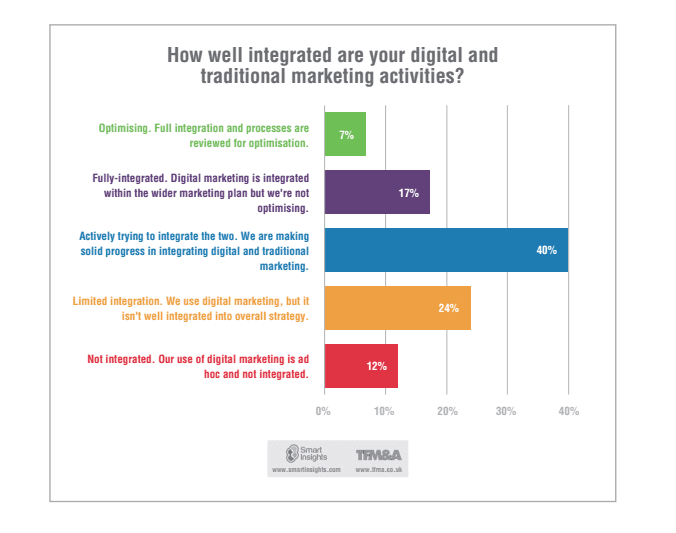
The chart certainly shows this is a challenge which many businesses are trying to meet. The most detrimental factor to ‘integrated planning’ is the lack of planning, as many companies have separate traditional marketing and digital marketing teams whom work independently when it comes to planning their marketing as Amanda Rendle refers to when she says:
“In many organisations where they are behind on digital what happens is they hire in someone to be a head of digital or ecommerce as separate functions.”
“All of a sudden, that person hires a load of marketer/customer experience champions, so you end up with two marketing departments. For any organisation it’s huge waste of resource to have two teams doing the same thing. That’s the real danger.
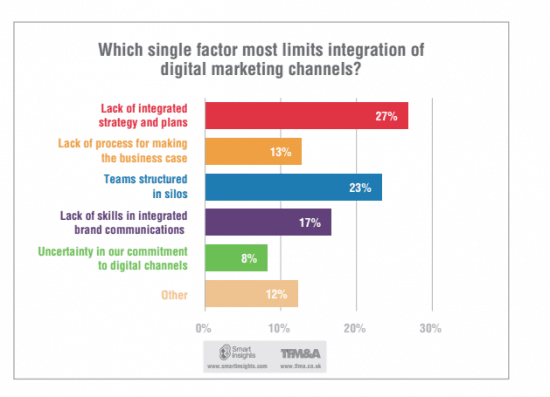
27% of businesses lacked integrated planning and teams were still structured in silos amongst 24% of our respondents.
How do you see it – do we live in a “post-digital world” or do you think specific digital marketing skills and roles will be required.
To see more predictions from Smart Insights commentating on which marketing techniques you should pay attention to in 2016 see our compilation of Digital Marketing Trends for 2016. It covers social media, email marketing and search.
From our sponsors: Marketing Trends for 2016 – Will we be in a post-digital era?



